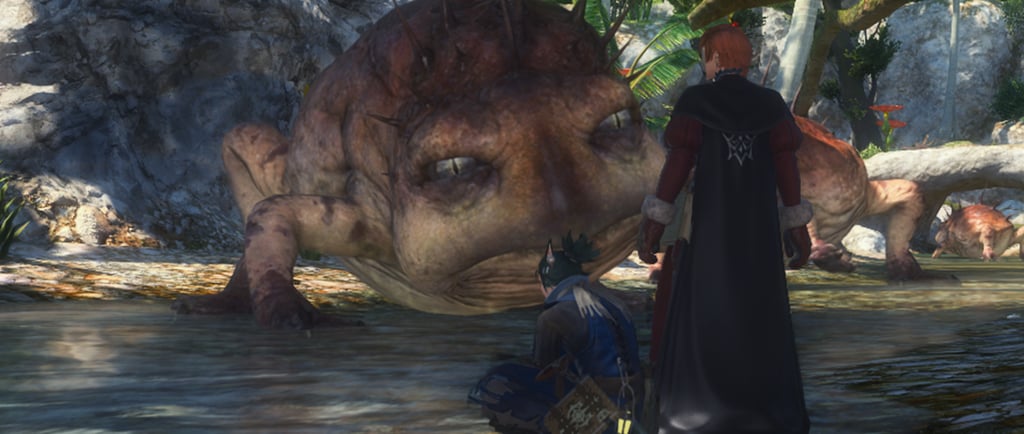Agelyss River Clean-Up Reveals Dangers
When cleaning up an ecological incident threatening Brayflox Longstop south of Wineport, environmentalists discovered a dangerous substance being called 'the rot'.
FEATUREDNEWSLIMSA LOMINSASCIENCE
Lehil Laruzedah
4 min read


On a Lightsday afternoon, a group of ecologists and environmental activists responded to a disaster in the Agelyss River. In amongst the chirps of crickets, the rustle of leaves, and the croaks of gigantoads, something was spreading in the river. It killed fish, vegetation, even Spoken who suffered serious exposure.
The Agelyss River forms the northern border of Raincatcher Gully in La Noscea. Just beyond the river lies Wineport, and downriver is Brayflox's Longstop. The river is vital not only to fauna and flora in the small jungle, but to the goblin community and vineyards that rely on its water. Any ecological disaster requires swift response both in terms of scientific investigation and a rapid cleanup effort. This is especially true in the case of the Agelyss river, whose waters so immediately impact two Spoken communities. Moreover, upriver from the contamination zone were the Raincatcher Gully docks, which help ship Wineport's products to the coast.
All this to say, the Agelyss River is uniquely important to La Noscea, but that the need to respond to these kinds of situations is far from unique. Enter the Gryphon's Collective, led in the field by Yumi Teruko.
Things began about how one would expect. Field agents of the Collective joined by volunteers tagged blighted vegetation, collected samples from the river, and removed the expected cause of the issue, a thick and murky substance that the Collective was calling 'the Rot.' The material seems to be able to infect living material, both flora and fauna, though it's specifics remain mysterious. This particular blight, also, has proven to resist any curative magic, regardless of formulation or origin. This has lead to speculation that the substance is not natural, and it poses significant danger to those caught unaware.
The intense work on that Lightsday was a tireless effort of a dedicated few - even our mascot Chocomere helped tag things for me to burn later - and as a result the damage was contained and anything infected was eliminated. But the effort took far passed just Lightsday.
"A proposed two-day river clean up has stretched into over a week of work as there is now an active hunt for a large threat in the forest that might be the cause of this rot's outbreak in Vylbrand," the Gryphon's Collective said in a statement. "The river is in much better condition and the rot's substance has been gathered to be properly disposed of in another location that is safe and hopefully won't contribute to any more illness or loss."
Part of the unexpected complications was an attack on the workers cleaning the river by a creature appearing to be a rot-infected and decaying Coeurl. The creature had killed at least one, a Roegadyn Maelstrom officer. The coeurl was dealt with by the volunteers in attendance, with fire proving as effective against the creature as it had been in clearing the blighted brush and trees.
One of those involved in the conflict with the coeurl, Tal'li Sayuun, was potentially exposed after being injured by the creature and knocked into the muck, but swift treatment and an impromptu purge of anything he might have swallowed appeared to leave him no worse for wear. The best efforts of Collective healers could not, however, save the Maelstrom officer.
As a result, the Collective returned with the Maelstrom to investigate the substance and it's potential deployment. While investigation is still underway, there team did find remains of a glamour prism, suggesting an intentional deployment of the Rot to this critical waterway.
"While we don't know the immediate cause of the rot, we are actively working on cutting the down the sources and working on cures," said the Collective's statement.
Sitting in the dirt of the forest floor, in the eerie quiet that came in aftermath of the Coeurl attack, those from the Collective were initially rather taciturn, though eventually began collecting and sharing what was known when the affair around the Agelyss River began.
First and most critically, though this was by far the highest-profile encounter the ecological community has had with the Rot, it isn't the first. The members of the Collective present that night discussed with the Courier an incident in Copperbell Mines in Thanalan. Teroku suggested some blighted Gysahl greens in the Black Shroud might've also been related.
Loreto Caro, one of the healers on site, questioned if it was an infection in the traditional sense at all. Instead he suspected a situation like a dense toxin being spread by a water source. Given the Rot's aether-resistant nature, he suspected it may be industrial waste from Garlean castrums that have sat abandoned since the end of the War.
"Infections need vectors," he said. "We haven't found this one yet. And if magic doesn't work - including my own advanced conjury, mind you - then perhaps we'll need tech."
According to BCC's science expert, Lara Eutrope, making something truly aetherproof is incredibly challenging. One solution would be harnassing a lot of what she called 'aether's antiparticle', a substance known as akasa or dynamis. Comparatively easy, however, is making something extremely aether-resistant. Garlean metamaterials heavily focused on expanding this field of study, relying on several tactics to make that resistance work. While she wouldn't rule out akasa as an explanation for the lack of effect of healing aether, she did find other ideas more compelling; aetheric refraction to reduce its effectiveness, for instance.
Until more is known about the Rot, everything about what it is and how it works remains purely speculative, but Gryphon's Collective is hard at work analyzing their samples to learn both what it is, and how to treat it.
The Black Chocobo Courier will have more on this story as it develops.